Trails and Tower
Dr. Haffer Trail
This morning we got on the boat to go upriver to the Dr. Haffer Trail. We found a Capybara and the usual river birds on the boat ride up. Jorge dropped us off at one end of the Dr. Haffer Trail. He would pick us up at the other end. The moment we entered the forest, Nick knew that birding would be difficult. The forest was too quiet. He was right.
Nonetheless, we managed to find some new birds. We'd been hearing Screaming Piha every day at Cristalino. On this trail, we walked into a group of them. After a long struggle, we managed to spot a Screaming Piha, and get everyone on it.
We also struggled with a couple of flatbills. I missed the Large-headed Flatbill (which I'd seen in the Atlantic forest), but did see the Dusky-tailed Flatbill. We managed to call in an Amazonian Antshrike and Manu Antbird (a bamboo specialist).
I've been surprised by the importance of bamboo. We spent some time concentrating on bamboo areas in the Atlantic forest, and today, it turned out to be important here too. In particular, Manu Antbird is a bamboo specialist. If we compare to the US, the only thing similar I can think of is the extinct Bachman's Warbler, which specialized in canebreaks in the south.
Kawalli Trailhead
Jorge took us back to the beginning of the Dr. Haffer Trail, where it meets the Kawalli Trail. We saw another Brazilian Tapir on the way. After 6 tries over the last few days, we finally saw the Flame-crowned Manakin. We also refound the Bronzy Jacamar. This time, everyone got to see it. It took quite a while to track down the inconspicuous Dwarf Tyrant-Manakin, even though it sings incessantly from a perch.
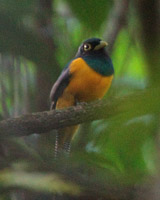 |
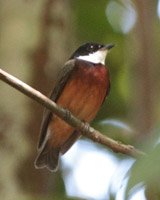 |
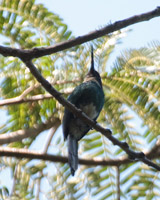 |
| Black-throated Trogon | Flame-crowned Manakin | Bronzy Jacamar |
The Amazon rainforest itself is quite different here than it was in my previous visit at Napo Wildlife Center in Ecuador. The forest here is mostly terra firme, while much of the forest around Napo is várzea. Moreover, there is a pronounced dry season at Cristalino, and we are in the middle of it. The character of the forest very much reminds of tropical hardwood hammocks in south Florida during February and March. In both cases, the trees have shed leaves, and there is a lot of dry leaf litter on the ground. That was not the case at Napo, which does not have the pronounced dry season.
We continued downriver, finding two Rusty-margined Flycatchers on an island before we arrived back at Cristalino in plenty of for lunch.
At some point today, we ran across a troop of Tufted Capuchin Monkeys. We decided to try an experiment, and played a Harpy Eagle call for them to see how they would react. They scattered, and moved below the canopy.
Cristalino Swimming Area
Some of us were out on the swimming deck during the afternoon. A number of birds came by. I took quite a few shots of the swallows, most of which didn't come out well. I even tried for one of the swifts! It's hard to track these fast-flying birds. Some of the other birds, such as the Swallow Tanagers, cooperatively perched.
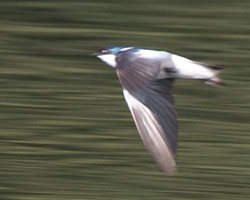 |
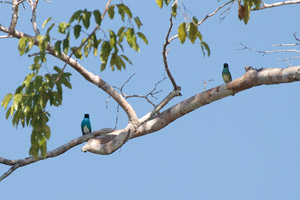 |
| White-winged Swallow | Swallow Tanagers |
There might have been more perched birds, had the Greater Yellow-headed Vulture not taken a prime perch. The parakeets in particular seemed to avoid the area while it was there. Before I left, a Fork-tailed Flycatcher showed up.
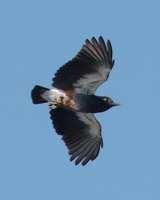 |
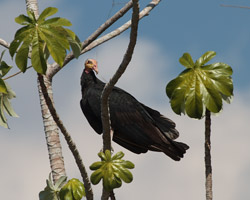 |
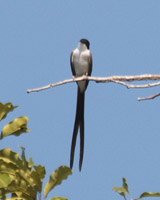 |
| Swallow-winged Puffbird | Greater Yellow-headed Vulture | Fork-tailed Flycatcher |
Canopy Tower
Later in the day we returned to the tower. A Ruddy Pigeon flew by, and several other birds were seen as the day ended. The last was a Red-fan Parrot who we watched calling from a perch as the sun set. Out night birding on the way back was unsuccessful. We heard Ocellated Poorwill on the way back, but were unable to see it. We tried to find a Crested Owl, also without success, although I did hear one shortly before falling asleep.
My bird total for the day was 63 species, including 7 lifers. The trip total increased by 10 to 482 species (477 seen), with 286 lifers.
Cristalino Jungle Lodge, Rio Cristalino